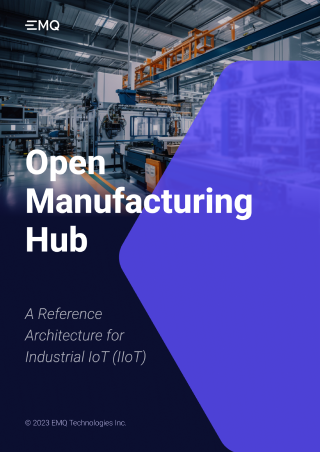Consolidating the Foundation of Smart Manufacturing with EMQX and Neuron

Table of Contents
- Event-Driven Architecture: The Essentials of Data-Centric Design
- Data-Driven Manufacturing: The Heart of Smart Manufacturing
- Connectivity and Integration: The Backbone of Smart Manufacturing
- Real-time Monitoring and Control: Empowering Decision-Making
- Cybersecurity Measures: Safeguarding Your Operations
- Challenges to Scaling Solutions: Growing with Confidence
- Conclusion: A Bright Future with EMQX and Neuron
In the age of Industry 4.0, the manufacturing landscape is undergoing a profound transformation. The emergence of smart manufacturing, driven by the integration of cutting-edge technologies, is revolutionizing the way companies produce goods. Key technologies driving this transformation include event-driven architecture, data-driven insights, connectivity and integration, real-time monitoring and control, cybersecurity, and scalability. In this blog post, we explore how the combined power of EMQX and Neuron serves as the technology foundation for smart manufacturing, delivering a host of benefits in these critical areas.
Event-Driven Architecture: The Essentials of Data-Centric Design
Event-driven Architecture (EDA) is a paradigm where the generation, detection, and consumption of events drive the behavior of connected systems and applications. An event can be any significant occurrence or change in a system, such as a sensor reading, a user action, a database update, or an external trigger. EDA allows these events to trigger reactions or processes, creating a dynamic and responsive ecosystem.
Decoupling in EDA refers to the separation of components or services within a system, allowing them to operate independently without direct dependencies on one another. Instead of components interacting through direct function calls or tight integrations, they communicate through events or messages. Decoupling is a fundamental concept in EDA that promotes system modularity and robustness, making it a valuable architectural choice for complex and evolving applications.

EMQX and Neuron offer significant advantages in EDA. They provide real-time responsiveness for quick reactions to critical events, scalable infrastructure to accommodate growing event volumes, and reliable event processing. Their flexibility allows EDA systems to adapt to changing requirements, while their efficiency reduces latency and resource usage, enhancing overall system performance.
The Role of EMQX in EDA
With EMQX, organizations can establish publish-subscribe mechanisms, where event producers publish messages to specific topics, and consumers subscribe to those topics of interest. This decoupled communication model ensures that events are delivered to the right consumers without tight dependencies. EMQX's scalability, support for QoS (Quality of Service) levels, and efficient message routing make it a robust choice for EDA implementations.
The Role of Neuron in EDA
Neuron supports various industrial protocols, including MQTT Sparkplug, OPC UA over MQTT, and more. It acts as the bridge between the physical world of sensors, machines, and devices and the digital realm of event processing. Neuron not only ensures data collection but also adds value through data transformation, filtering, and aggregation, aligning the data with the specific needs of consumers.
Data-Driven Manufacturing: The Heart of Smart Manufacturing
In the world of smart manufacturing, data is the most important resource. It is critical in informed decision making, process optimization and overall efficiency. EMQX, a robust MQTT broker, and Neuron, an industrial connectivity gateway, work together to provide a comprehensive data collection solution. They seamlessly collect data from multiple sources within the manufacturing environment, including sensors, machines, and IoT devices. This ensures that your data collection process is comprehensive and ready for advanced analytics.
But data collection is only the beginning. Data quality and integrity are critical. EMQX and Neuron step in to ensure secure and reliable data transfer, reducing the risk of data corruption or loss. This means that the data used for analysis and decision support is not only plentiful, but also highly accurate and trustworthy.

Connectivity and Integration: The Backbone of Smart Manufacturing
Connectivity and integration are the glue that holds the smart manufacturing ecosystem together. EMQX, an MQTT broker, and Neuron, a versatile industrial connectivity gateway, excel at facilitating seamless data exchange. They provide various industrial protocols and create connections between devices, sensors and systems across the manufacturing landscape, effectively breaking down data silos.
These solutions are critical to realizing the full potential of the Internet of Things (IoT). With EMQX and Neuron, real-time data transfer and integration become a reality. Data from disparate devices is easily accessible and actionable, strengthening connectivity across the manufacturing ecosystem.
Real-time Monitoring and Control: Empowering Decision-Making
In smart manufacturing, real-time monitoring and control is the key to agility and efficiency. EMQX and Neuron make this possible by supporting real-time data processing and analysis. Their low-latency communications and edge computing capabilities allow data to be collected and processed at the edge of the network. This translates into real-time monitoring and control, enabling faster decisions and responses to changing conditions.
Moreover, EMQX and Neuron seamlessly integrate with advanced analytics and machine learning platforms. This means you can use predictive maintenance models, anomaly detection algorithms and other cutting-edge analytics to optimize processes.
Cybersecurity Measures: Safeguarding Your Operations
The importance of cybersecurity in smart manufacturing cannot be overstated. With increased connectivity and data exchange, manufacturing processes and data are prime targets for cyber threats. EMQX and Neuron take cybersecurity seriously. EMQX includes Access Control Lists (ACLs) to control access to topics, ensuring that data remains secure in transit. Neuron complements this by supporting secure protocols such as MQTT Sparkplug and OPC UA over MQTT, further enhancing data protection.
Authentication and authorization are also top priorities. Both EMQX and Neuron support role-based access control, allowing organizations to restrict data access based on user roles and responsibilities. This robust authentication and authorization mechanism strengthens cybersecurity measures and provides peace of mind in an increasingly digital world.
Challenges to Scaling Solutions: Growing with Confidence
As your manufacturing operations expand, scaling complex technology solutions can be daunting. EMQX and Neuron are designed to grow with you. EMQX's high-speed data replication capabilities and support for multi-site synchronization make it well suited for scaling solutions across a growing manufacturing network. Neuron's edge-native design ensures that it can be deployed on multiple hardware platforms, providing the flexibility to scale easily.
Interoperability is another concern when scaling solutions. EMQX and Neuron address this challenge by supporting standard protocols and data exchange formats. This ensures seamless integration across different manufacturing systems and devices, making scaling an efficient and streamlined process.
Conclusion: A Bright Future with EMQX and Neuron
The collaboration between EMQX and Neuron sets the stage for a thriving smart manufacturing ecosystem. By providing solutions for data-driven decision-making, seamless connectivity and integration, real-time monitoring and control, robust cybersecurity, and scalability, they enable companies to confidently navigate the complexities of modern manufacturing. With EMQX and Neuron as the foundation, the future of smart manufacturing is bright, efficient, and secure.
